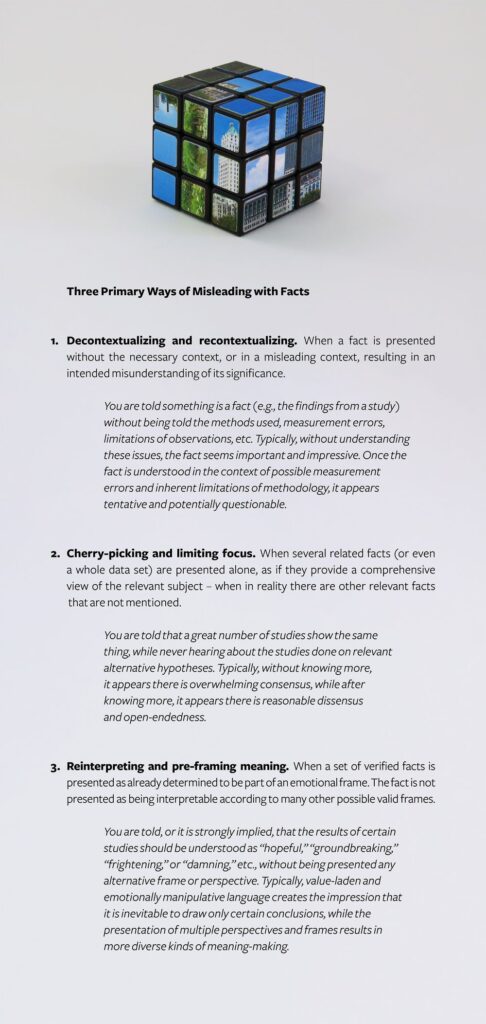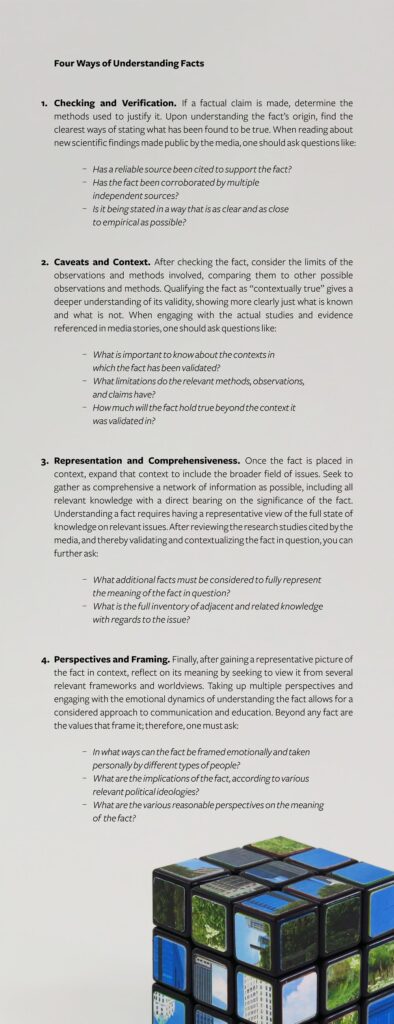Verified facts can be used to support erroneous conclusions. Here is how we can put an end to that.
Fact-checking has become popularized as the definitive process for certifying truth in the media. This has occurred in response to the proliferation of a wide variety of internet subcultures, often based largely upon misinformation. Propaganda and bad faith communication are all too common, making the checking of facts an important part of sensemaking.
While fact-checking is necessary, it is often not enough to provide the whole picture. Under current conditions of escalating culture and information war, facts themselves have become weapons.[1] Neither propaganda nor bad faith communication require the speaking of falsehoods.[2] It is often more effective to mislead and misinform through a strategic use of verified facts. The ability to critique and correct for the misuse of facts in public culture is an essential component of the democratic way of life.
Unfortunately, today it is standard practice for both institutions and individuals from all sectors of society to offer strategically cherry-picked and decontextualized facts,[3] set within a predetermined emotional or ethical frame.[4] This way of using facts is an effective tool to bring some people towards previously unappealing conclusions. It also provides rhetorical ammunition to those already predisposed to drawing these conclusions. While honestly passing the scrutiny of the fact-checkers, such an approach is nevertheless far from entirely truthful.
Verified facts are collected as ammunition for culture war, rather than for the sake of gaining a comprehensive understanding.
In today’s so-called “post-truth” digital media landscapes, the practice of weaponizing facts has become widespread, microtargeted, and optimized for psychological impact. The normalization of mishandling facts threatens to undermine people’s sense of living in a shared reality. For some, it goes so far as to undermine the idea that reality can be known at all.
Democratic forms of government are now being undermined by the mishandling and misrepresentation of “facts.” Stopping our descent into a “fact-blind culture” requires a new approach to the way we pay attention to and talk about “the facts.” For those seeking to improve the state of the epistemic commons, and address 21st-century challenges to sensemaking, there is no way forward that does not involve fundamental upgrades to how “facts” are handled in public discourse.[5]
There is a growing body of literature on fact-checking as a media practice.[6][7][8][9] The fields of epistemology and the philosophy of science now have sub-branches seeking to address the crisis concerning “facts” in public culture. A thriving international movement of fact-checking is leading to the establishment of many new organizations aimed at certifying the truth. The details of these efforts can be found elsewhere.[10]
Despite often earnest effort, the recent growth of fact-checking is not making the situation obviously better. Some argue that more fact-checking is in fact making things worse. How can that be?
The answer is that fact-checking—the verification of specific claims—does nothing to address the three primary ways in which facts can be used to mislead (see the box below). Because fact-checking offers official verification, it permits easier use of facts to mislead and misinform. This sounds counterintuitive. But the more accepted a fact is, the greater its effect when it is made part of a misleading campaign.

A misleading campaign of facts runs according to some combination of the three primary ways outlined in the box above. Information campaigns that are factually truthful but nevertheless misleading are the stuff of classic propaganda, as we have documented in our recent series on the problem of modern propaganda.[11] For decades there has been cumulative innovation in the industry of public relations.[12] Techniques for misleading with facts have been continually and scientifically advanced.
Facts become weapons for use in politically charged discourses in which winning is more important than accurately representing larger and more complex truths.
Today, the strategic misuse of facts is becoming a common practice employed by everyday citizens on social media. Many people post to their social media feeds only those facts they endorse, which support their existing beliefs and ideologies. Verified facts are collected as ammunition for culture war, rather than for the sake of gaining a comprehensive understanding. Microtargeting then caters to these preferences, ensuring that there is a steady supply of cherry-picked facts on offer. The resultant filter bubbles and algorithmic radicalization have been discussed in our related paper on 21st-century information warfare.[13]
The algorithmic radicalization prevalent on social media does not require “fake news.” Because facts can be used to mislead, extreme polarization and ideological identity capture can occur when individuals engage with information that is factual. This is possible when facts are taken out of context, cherry-picked, and emotionally loaded. Facts become weapons for use in politically charged discourses in which winning is more important than accurately representing larger and more complex truths. This debases the usefulness of “facts” and fact-stating discourses, which is to debase a necessary component of adequate public sensemaking.[14]
But what would happen if we decided to slow down and think about the facts together? What if we really wanted to understand what was going on in a way that accounted for all the facts and their various frames and interpretations?
The rivalrous “checking” of facts must give way to a more collaborative mutual understanding of facts. With a focus on education, this approach requires that individuals seek earnestly to evaluate the complexity of factual claims. Working together, individuals engage in a collaborative process to understand the implied significance and meaning of the facts in question, including all the associated complexity and nuance. There are four essential ways of understanding facts (see Box 2). Understanding facts requires a process that transcends but includes the familiar process of fact-checking, adding considerations of context, representativeness, and framing.

Beyond simply verifying a fact, it must be…



